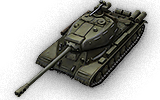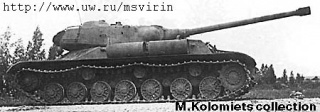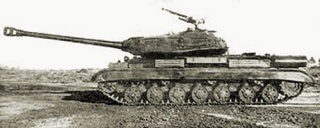IS-4
IS-4 (Stock)
| 6100000 Preis |
| 2200 SPRobustheit |
| 60.02 / 66.3 Gewicht |
- Kommandant
- Funker
- Richtschütze
- Fahrer
- Ladeschütze
| 140/160/100Wannenpanzerung(Front/Seiten/Heck mm) |
| 250/200/170Turmpanzerung(Front/Seiten/Heck mm) |
| 750 PSMotorleistung |
| 43 km/hHöchstgeschwindigkeit vorwärts/rückwärts |
| 25 °/sDrehen/Wenden |
| 400 damage |
| 175 mmMittlere Durchschlagskraft |
| 11.3353370545298 Dauer für vollständiges Nachladen |
| 17 °/sGeschützrichtgeschwindigkeit |
| 250 mSichtweite |
| 500 mFunkreichweite |

The IS-4 is quite a versatile tank, with a good gun, and thick sloped armor. These are opposed by its somewhat low speed and agility. When armed with the 122mm M62-T2 gun, it becomes a fearsome opponent, capable of belting out generous amounts of damage. It trades frontal armor from its predecessor, the ST-I, in exchange for better side armor and higher mobility. It sports better penetration and rate of fire, it still is far from being as nimble as its counterpart, the IS-7, and feels very sluggish and slow in comparison. While its frontal armor is thinner than other tier X tanks, it compensates by having a great slope on the frontal armor plating, meaning that you will bounce enemy shots effectively. Unfortunately, the lower front plate is very soft and a rather big target to hit, effectively negating the good slope of the upper front plate. Therefore, it is best to either hull-down or position yourself at an angle to maximize your sloped armor. Take into consideration that you are a close-range brawler, not a sniper, as your guns have poor or mediocre accuracy at best, and if you miss a shot it can be painful. You do not have the speed and maneuverability to get yourself into position quickly and relocate if needed. However, you can utilize cover sufficiently effective - peek out, fire a shot at the enemy, then dive back into safety. The good side armor also makes it very suitable for side scraping. Generally, it is more well-rounded over the IS-7, but it doesn't have any extremely strong points.


Turm
| Stufe | Turm | Turmpanzerung (Front/Seiten/Heck mm) | Geschützrichtgeschwindigkeit (°/s) | Sichtweite (m) | Erfahrung | Gewicht (t) |
|---|---|---|---|---|---|---|
| X | IS-4M | 250/200/170 | 17 | 250 | 0 | 14200 |
| Stufe | Geschütz | Mittlere Durchschlagskraft (mm) | Feuergeschwindigkeit | Streuung auf 100 m | Zielerfassung | Erfahrung | Gewicht (t) | |
|---|---|---|---|---|---|---|---|---|
| VIII | 122 mm D-25T | 175/217/61 | 400/400/500 | 5.29 | 0.46 | 2.9 | 0 | 2590 |
| X | 122 mm M62-T2 | 258/340/68 | 420/420/500 | 5.29 | 0.38 | 2.9 | 61000 | 3397 |

Motor
| Stufe | Motor | Motorleistung (PS) | Brandwahrscheinlichkeit bei Treffer | Erfahrung | Gewicht (t) |
|---|---|---|---|---|---|
| X | V-12 | 750 | 15 | 0 | 1024 |

| Stufe | Fahrwerk | Maximalgewicht | Drehen/Wenden (°/s) | Erfahrung | Gewicht (t) |
|---|---|---|---|---|---|
| X | IS-4 | 66.3 | 25 | 0 | 11000 |

Funkgerät
| Stufe | Funkgerät | Funkreichweite (m) | Erfahrung | Gewicht (t) |
|---|---|---|---|---|
| X | _10RK-26 | 500 | 0 | 160 |
Compatible Equipment
Compatible Consumables
Player Opinion
Pros and Cons
Pros:
- Excellent turret armor with strong nose and sides
- Larger hitpoint pool more reminiscent of a heavy tank unlike IS-7
- Very good thick hull armor with creative sloping to allow a range of defensive tactics
- Excellent side armor thickness and slope allows for excellent sidescraping abilities
- Lower profile makes weak spots difficult to target
Cons:
- Very poor traverse speed and ground resistance makes the tank feel sluggish
- Below average gun handling and below average DPM
- Driver vulnerable from frontal hits and damaged often
- Small ammunition capacity can be a factor in drawn out engagements
Performance
IS-4 can be an excellent tank when played properly. Its’ lack of low end mobility can limit the available play styles, yet when the strong turret, side armor, and penetration are taken advantage of, this tank can be invaluable.
Of the tactics IS-4 does well, hull down is likely its’ best. The turret is exceptionally strong from the front, capable of deflecting all but tier X Tank Destroyer rounds. It does however have a weak hatch door similar to an IS-3 or IS-6, requiring drivers need to ensure they have an elevated hull down position over their target. Even a few meters of elevation is all that’s needed to mitigate the weak hatch. When truly hull down, IS-4 can loiter there, fully aim, and easily penetrate weak armor points on most enemy tanks. Locations such as the windmill at Winter Malinovka, top hill on Copperfield, caves at Black Goldville are examples of terrain where this tank is most effective.
IS-4’s other main strength is sidescraping. The side armor is thick, heavily sloped, and riddled with spaced portions. At a proper angle, one can reliable reliably deflect even Tier X tank destroyer rounds if necessary. IS-4 drivers should hope to engage other heavy tanks in areas where the side armor can be taken advantage of. When setting up a position for side scraping, one must remember to always have the enemy fire and miss/bounce first, as the frontal armor is not as reliable and will be slightly vulnerable when a proper shot can be returned.
IS-4 drivers should be cautious whenever engaging medium tanks as the poor traverse and low end acceleration make it very vulnerable to circle tactics. When engaging medium tanks, defending at medium or greater range will increase chances for success. Despite this weakness, IS-4 should not be choosing locations that are medium tank friendly. It instead should be looking to mix it up with enemy heavy tanks or hold a front line position.
Historical Info
Historical Gallery
Sources and External Links
| Light Tanks | IMS-1 • IIBT-2 • IIT-26 • IITetrarch • IIIBT-7 • IIIBT-SV • IIILTP • IIIM3 Light • IIIT-127 • IIIT-46 • IVA-20 • IVValentine II |
| Medium Tanks | IVA-32 • IVT-28 • VMatilda IV • VT-34 • VIT-34-85 • VIT-34-85 Victory • VIIKV-13 • VIIT-34-85 Rudy • VIIT-43 • VIIIT-44 • IXT-54 • XObjekt 140 • XT-62A |
| Heavy Tanks | VChurchill III • VKV-220 Beta-Test • VKV-1 • VIKV-1S • VIKV-2 • VIT-150 • VIIIS • VIIKV-3 • VIIIIS-3 • VIIIIS-6 • VIIIIS-6 Fearless • VIIIKV-5 • VIIIKV-4 • IXIS-8 • IXST-I • XIS-4 • XIS-7 |
| Tank Destroyers | IIAT-1 • IIISU-76 • IVSU-85B • VSU-85 • VSU-85I • VISU-100 • VISU-100Y • VIISU-152 • VIISU-100M1 • VIISU-122-44 • VIIIISU-152 • VIIISU-101 • IXObjekt 704 • IXSU-122-54 • XObjekt 263 • XObjekt 268 |
| USA | VT14 • VT1 Heavy Tank • VIM6 • VIIT29 • VIIIT32 • VIIIT34 • VIIIT34 Independence • IXM103 • XT110E5 |
| UK | VChurchill I • VExcelsior • VIChurchill VII • VITOG II* • VIIBlack Prince • VIIICaernarvon • IXConqueror • XFV215b |
| Germany | IVPz.Kpfw. B2 740 (f) • IVDurchbruchswagen 2 • VVK 30.01 (H) • VIVK 36.01 (H) • VIITiger I • VIITiger (P) • VIITankenstein • VIIILöwe • VIIITiger II • VIIIVK 45.02 (P) Ausf. A • IXE 75 • IXVK 45.02 (P) Ausf. B • XE 100 • XMaus |
| USSR | VChurchill III • VKV-220 Beta-Test • VKV-1 • VIKV-1S • VIKV-2 • VIT-150 • VIIIS • VIIKV-3 • VIIIIS-3 • VIIIIS-6 • VIIIIS-6 Fearless • VIIIKV-5 • VIIIKV-4 • IXIS-8 • IXST-I • XIS-4 • XIS-7 |
| France | |
| China | |
| Japan | |
| Czechoslovakia | |
| Sweden |

